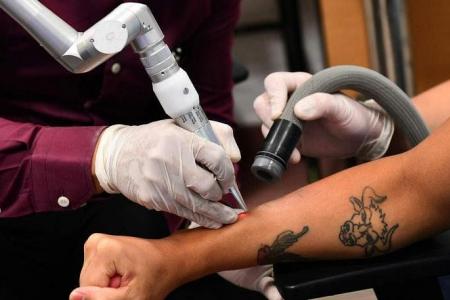Tattoo removals subsidised for young people finding work or trying to stay in school
Two years ago, secondary school student Muhammad Dani decided on impulse to get his wrist and calf tattooed at a friend’s house, a decision he later regretted.
“I made the wrong decisions and followed through with my desire when I saw a group of friends having tattoos. Without giving it a second thought, I decided to have tattoos as well,” said the 15-year-old.
The tattoos were in violation of his school’s code of conduct. Students who violate the code are subject to disciplinary measures, including suspension.
Looking for a way to help Dani remove the tattoos and complete his education, school student welfare officer Edwin Lim told Dani about a tattoo removal programme run by the National Skin Centre (NSC) and supported by its Health Fund (NSCHF).
The school said it would continue to allow Dani to attend school if he committed to removing his tattoos and concealing them in the meantime.
The tattoo removal scheme started in 2019 with the collaboration of the Ministry of Education.
It received referrals from family service centres, youth centres, and agencies that run programmes for at-risk youth and young offenders under 21 who had committed minor offences.
In September 2022, NSC expanded the scheme to include those in juvenile homes.
NSCHF chairman Eunice Tay said the scheme arose from “a deep concern for students who may have been wrongly advised to undergo tattooing, which may be potentially detrimental to their future careers”.
Costly tattoo removal at private clinics could discourage parents and students from deciding to remove the tattoo, she added.
Under the NSC programme, cumulative costs below $1,200 are fully subsidised. Beyond the cap, patients co-pay 10 per cent, a nominal sum meant to ensure commitment to the programme.
The general cost of each tattoo removal session ranges from $300 to $500.
Dr Suzanne Cheng, a consultant at NSC, said the average number of sessions required ranges from five to 10.
Each session is spaced about two months apart, meaning that fully removing a tattoo could take about a year at least.
The number of sessions required depends on several factors, including tattoo colour, how long the tattoo has been there, and whether it was done by a professional or an amateur.
Black and blue-black tattoos respond best to laser removal, followed by green, red, orange, yellow and white ones, said Dr Cheng.
Longstanding tattoos are harder to remove. Professional tattoos also tend to be deeper in the skin and darker, and hence need more laser sessions, she added.
She has seen all kinds of tattoo designs, from musical scores, dragons and Chinese characters, to swear words and amateur drawings of stick men.
During each session, the laser removal process itself takes from five to 30 minutes, depending on the size of the tattoo. There is also a 45- to 60-minute wait after the numbing cream is applied before the laser treatment begins.
Dr Cheng said that the process can be very painful, especially if the tattoo is very dark to begin with, or if it covers bony areas.
Dani said that his tattoos were of a devil on his calf, and a trendy design on his wrist that he had seen on other people.
“In a way, I am glad that the tattoos were not done by professionals, as the amateur skills of my friend made it easier to remove the tattoos,” he said.
He has had four sessions since January 2022, which have almost completely removed the tattoos.
Professor Tan Suat Hoon, director of the NSC, said those eligible for the programme are school students with tattoos who need them removed to avoid disciplinary measures, or young people looking for gainful employment.
“This is especially for those who have visible tattoos on their bodies, which... may be associated with their past offences and behaviour, and gang associations. It is for youths who want to turn over a new leaf, to help them remove a visible social stigma,” she said.
As at December 2022, the NSC programme has received 36 patients – 19 male, 17 female – who have completed a total of 67 treatment sessions.
One challenge is that some do not stay on the treatment plan.
Twelve of the participants dropped out, mostly due to changing family or life situations that influenced their motivation or capacity to follow through with removal, said Mr Chan Ming Hui, a medical social worker at NSC.
These include early marriage, or starting work after graduation from secondary or post-secondary education, he added.
Prof Tan said how cooperative those still in the programme are with treatment depends on their motivation.
Those who are focused on national exams and employment are very cooperative, while those outside the school system require significant engagement and encouragement from parents, guardians and social workers, she added.
Mrs Tay said NSCHF hopes the scheme can provide help to more young people who are seeking it.
“While society’s views may be changing with regard to tattooing as a form of body art, we are here to help the forgotten ones who may need some help to get back on track with their lives and integrate with society,” she added.
Get The New Paper on your phone with the free TNP app. Download from the Apple App Store or Google Play Store now


